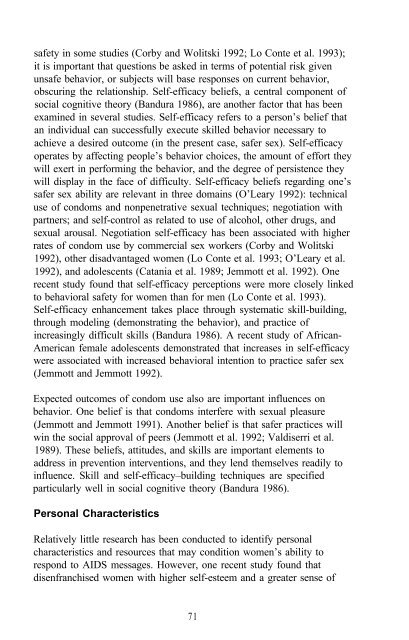The Context of HIV Risk Among Drug Users and Their Sexual Partners
The Context of HIV Risk Among Drug Users and Their Sexual Partners
The Context of HIV Risk Among Drug Users and Their Sexual Partners
Create successful ePaper yourself
Turn your PDF publications into a flip-book with our unique Google optimized e-Paper software.
safety in some studies (Corby <strong>and</strong> Wolitski 1992; Lo Conte et al. 1993);<br />
it is important that questions be asked in terms <strong>of</strong> potential risk given<br />
unsafe behavior, or subjects will base responses on current behavior,<br />
obscuring the relationship. Self-efficacy beliefs, a central component <strong>of</strong><br />
social cognitive theory (B<strong>and</strong>ura 1986), are another factor that has been<br />
examined in several studies. Self-efficacy refers to a person’s belief that<br />
an individual can successfully execute skilled behavior necessary to<br />
achieve a desired outcome (in the present case, safer sex). Self-efficacy<br />
operates by affecting people’s behavior choices, the amount <strong>of</strong> effort they<br />
will exert in performing the behavior, <strong>and</strong> the degree <strong>of</strong> persistence they<br />
will display in the face <strong>of</strong> difficulty. Self-efficacy beliefs regarding one’s<br />
safer sex ability are relevant in three domains (O’Leary 1992): technical<br />
use <strong>of</strong> condoms <strong>and</strong> nonpenetrative sexual techniques; negotiation with<br />
partners; <strong>and</strong> self-control as related to use <strong>of</strong> alcohol, other drugs, <strong>and</strong><br />
sexual arousal. Negotiation self-efficacy has been associated with higher<br />
rates <strong>of</strong> condom use by commercial sex workers (Corby <strong>and</strong> Wolitski<br />
1992), other disadvantaged women (Lo Conte et al. 1993; O’Leary et al.<br />
1992), <strong>and</strong> adolescents (Catania et al. 1989; Jemmott et al. 1992). One<br />
recent study found that self-efficacy perceptions were more closely linked<br />
to behavioral safety for women than for men (Lo Conte et al. 1993).<br />
Self-efficacy enhancement takes place through systematic skill-building,<br />
through modeling (demonstrating the behavior), <strong>and</strong> practice <strong>of</strong><br />
increasingly difficult skills (B<strong>and</strong>ura 1986). A recent study <strong>of</strong> African-<br />
American female adolescents demonstrated that increases in self-efficacy<br />
were associated with increased behavioral intention to practice safer sex<br />
(Jemmott <strong>and</strong> Jemmott 1992).<br />
Expected outcomes <strong>of</strong> condom use also are important influences on<br />
behavior. One belief is that condoms interfere with sexual pleasure<br />
(Jemmott <strong>and</strong> Jemmott 1991). Another belief is that safer practices will<br />
win the social approval <strong>of</strong> peers (Jemmott et al. 1992; Valdiserri et al.<br />
1989). <strong>The</strong>se beliefs, attitudes, <strong>and</strong> skills are important elements to<br />
address in prevention interventions, <strong>and</strong> they lend themselves readily to<br />
influence. Skill <strong>and</strong> self-efficacy–building techniques are specified<br />
particularly well in social cognitive theory (B<strong>and</strong>ura 1986).<br />
Personal Characteristics<br />
Relatively little research has been conducted to identify personal<br />
characteristics <strong>and</strong> resources that may condition women’s ability to<br />
respond to AIDS messages. However, one recent study found that<br />
disenfranchised women with higher self-esteem <strong>and</strong> a greater sense <strong>of</strong><br />
71
















